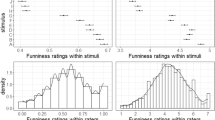Abstract
Humour classification is one of the most interesting and difficult tasks in text classification. Humour is subjective by nature, yet humans are able to promptly define their preferences.
Nowadays people often search for humour as a relaxing proxy to overcome stressful and demanding situations, having little or no time to search contents for such activities. Hence, we propose to aid the definition of personal models that allow the user to access humour with more confidence on the precision of his preferences.
In this paper we focus on a Support Vector Machine (SVM) active learning strategy that uses specific most informative examples to improve baseline performance. Experiments were carried out using the widely available Jester jokes dataset, with encouraging results on the proposed framework.
Access this chapter
Tax calculation will be finalised at checkout
Purchases are for personal use only
Preview
Unable to display preview. Download preview PDF.
Similar content being viewed by others
References
Mihalcea, R., Strapparava, C.: Making computers laugh: investigations in automatic humor recognition. In: Proceedings of the Conference on Human Language Technology and Empirical Methods in Natural Language Processing, HLT 2005, pp. 531–538. Association for Computational Linguistics, Stroudsburg (2005)
Stock, O., Strapparava, C.: Getting serious about the development of computational humor. In: IJCAI 2003, pp. 59–64 (2003)
Baram, Y., El-Yaniv, R., Luz, K.: Online choice of active learning algorithms. In: Proceedings of ICML-2003, 20th International Conference on Machine Learning, pp. 19–26 (2003)
Vapnik, V.: The Nature of Statistical Learning Theory. Springer, Heidelberg (1999)
Joachims, T.: Learning Text Classifiers with Support Vector Machines. Kluwer Academic Publishers, Dordrecht (2002)
Tong, S., Koller, D.: Support vector machine active learning with applications to text classification. The Journal of Machine Learning Research 2, 45–66 (2002)
Antunes, M., Silva, C., Ribeiro, B., Correia, M.: A hybrid AIS-SVM ensemble approach for text classification. In: Dobnikar, A., Lotrič, U., Šter, B. (eds.) ICANNGA 2011, Part II. LNCS, vol. 6594, pp. 342–352. Springer, Heidelberg (2011)
Mihalcea, R., Strapparava, C.: Technologies That Make You Smile: Adding Humor to Text-Based Applications. IEEE Intelligent Systems 21(5), 33–39 (2006)
Settles, B.: Active learning literature survey. CS Technical Report 1648. University of Wisconsin-Madison (2010)
Silva, C., Ribeiro, B.: On text-based mining with active learning and background knowledge using svm. Soft Computing-A Fusion of Foundations, Methodologies and Applications 11(6), 519–530 (2007)
McCallum, A.K., Nigam, K.: Employing EM and pool-based active learning for text classification. In: Proceedings of ICML-1998, 15th International Conference on Machine Learning, pp. 350–358. Morgan Kaufmann Publishers, San Francisco (1998)
Binsted, K., Ritchie, G.: An implemented model of punning riddles. arXiv.org, vol. cmp-lg (June 1994)
Reyes, A., Potthast, M., Rosso, P., Stein, B.: Evaluating Humor Features on Web Comments. In: Proceedings of the Seventh Conference on International Language Resources and Evaluation (LREC 2010) (May 2010)
van Rijsbergen, C.: Information Retrieval. Butterworths ed. (1979)
Author information
Authors and Affiliations
Editor information
Editors and Affiliations
Rights and permissions
Copyright information
© 2011 Springer-Verlag Berlin Heidelberg
About this paper
Cite this paper
Costa, J., Silva, C., Antunes, M., Ribeiro, B. (2011). The Importance of Precision in Humour Classification. In: Yin, H., Wang, W., Rayward-Smith, V. (eds) Intelligent Data Engineering and Automated Learning - IDEAL 2011. IDEAL 2011. Lecture Notes in Computer Science, vol 6936. Springer, Berlin, Heidelberg. https://doi.org/10.1007/978-3-642-23878-9_33
Download citation
DOI: https://doi.org/10.1007/978-3-642-23878-9_33
Publisher Name: Springer, Berlin, Heidelberg
Print ISBN: 978-3-642-23877-2
Online ISBN: 978-3-642-23878-9
eBook Packages: Computer ScienceComputer Science (R0)




